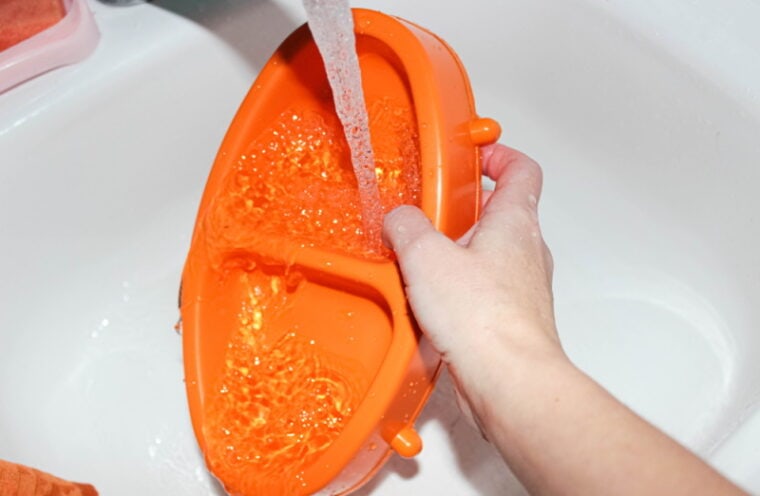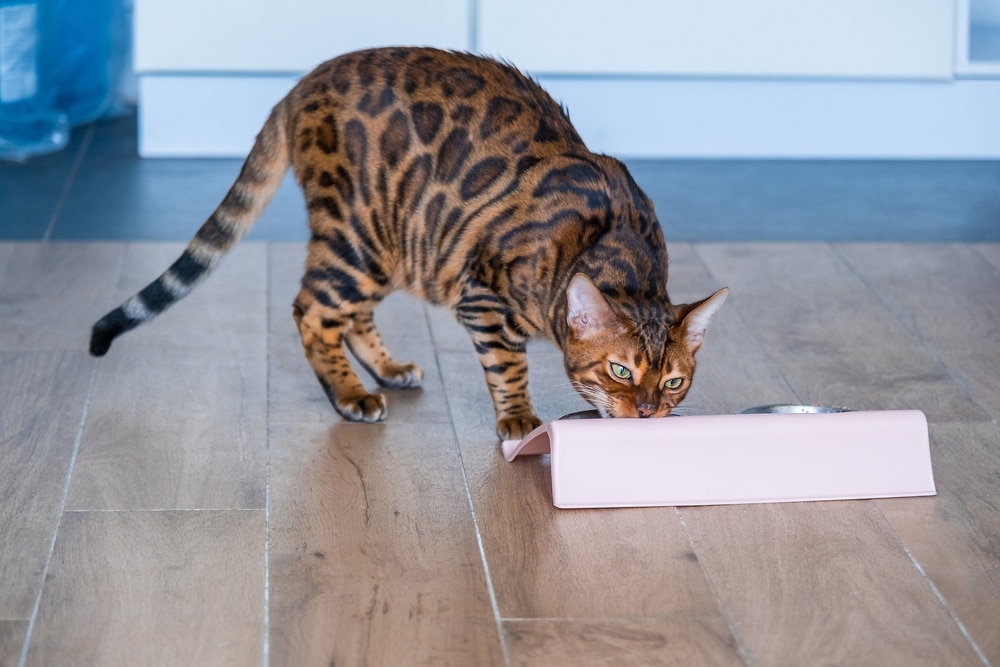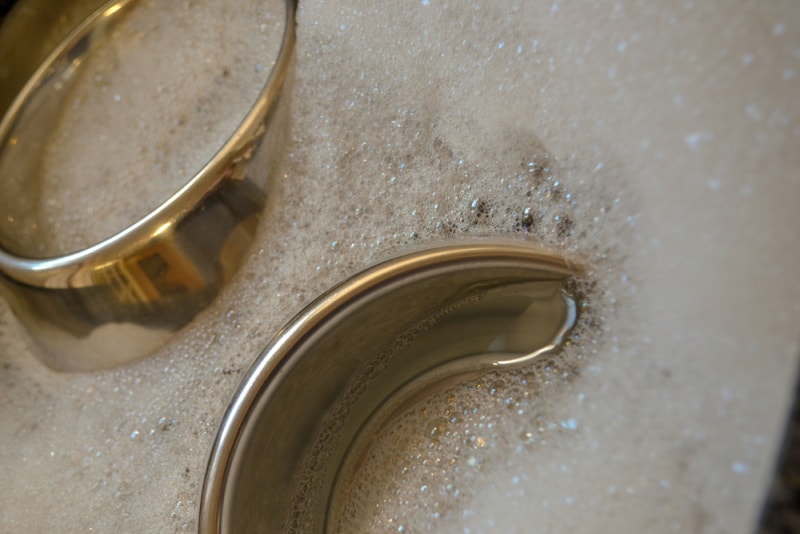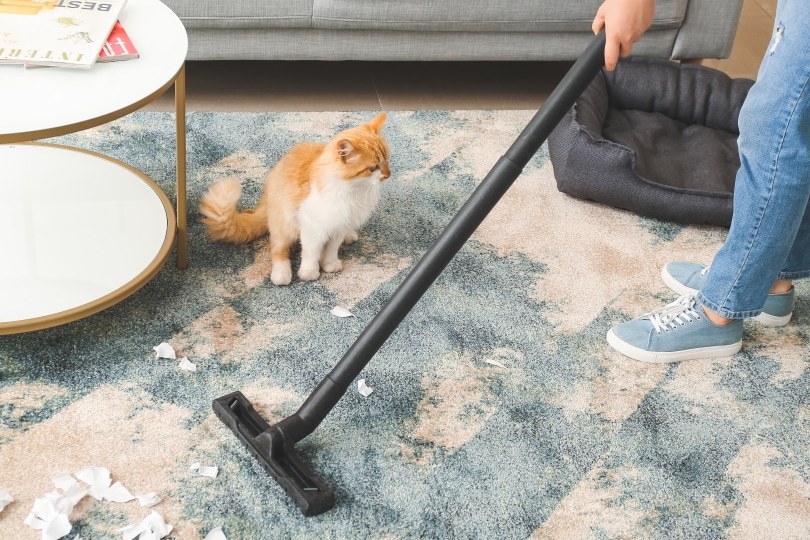
If you have a feline companion at home, you probably know how picky cats can be when it comes to having a clean living environment. While most owners are aware that their pet’s litter should be regularly cleaned, the importance of giving food and water bowls regular attention often receives less emphasis. Cats’ food bowls should be washed after every use, and water bowls need daily cleaning to stay hygienic. Read on for more on how to keep your cat’s food and water bowls clean.
What Happens if Cats’ Food and Water Bowls Aren’t Washed Frequently Enough?
Cats’ water bowls accumulate bacteria from the environment and from your cats’ mouth when they drink. Leftover food bits attract ants, other insects and possibly rodents. It also allows bacteria to proliferate and a biofilm forms1. This is the slimy layer you can feel in the water bowl. A combination of bacteria in a slime matrix. Just as humans should avoid things like day-old unrefrigerated egg salad because of the risks associated with ingesting harmful bacteria, cats should stay away from bowls with remnants of the old food. Food and water bowls provide bacteria such as E.coli and salmonella with welcoming environments to thrive. Salmonella infection can cause vomiting, diarrhea, dehydration, and lethargy in cats2.
Veterinarians often use the results of urine, fecal, and blood tests to diagnose feline gastrointestinal problems. Treating pets with salmonella requires strict hygiene to prevent transmission to human family members.

What’s the Best Way to Clean Cat Food and Water Dishes
Water dishes should be rinsed daily before adding fresh, clean water. They should be washed at least every second day with hot water and dish soap to remove the biofilm build up. Cat fountains usually require at least weekly deep cleaning to keep things clean and prevent build-up from developing and lowering the product’s overall cleanliness and efficiency. You may need to disassemble the unit to reach the pump and other parts that often benefit from a good clean. The fountain’s filters require regular replacements, usually around every 2 or 3 weeks or so.
Dry food-only bowls should be washed with hot water and soap at least once daily, and bowls should be cleaned immediately with hot soapy water after all wet food meals. Use a dedicated sponge to clean your pet’s dishes to avoid transferring bacteria from your cat’s bowls to your family’s dinner plates. Stainless steel and some ceramic options can be thrown in the dishwasher for a deep, weekly clean.
Avoid ceramic options that aren’t designed for food consumption, as the glaze may contain harmful chemicals such as lead. Throw out chipped or cracked ceramic products as they’re great bacteria breeding grounds.
Plastic bowls are convenient but often crack and retain bacteria, making them less than ideal permanent options. Make sure to use a feline-friendly soap when washing your cat’s food and water bowls, and rinse everything well in clean water to ensure your buddy doesn’t ingest any leftover soap.

Cleaning Tips for Living With a Cat
Cats aren’t messy creatures, but there are still a few housekeeping tasks that come with having a feline companion.
HEPA Filters
HEPA filters and regular vacuuming are important in keeping homes free of pet dander. Reducing environmental allergy triggers like pet dander improves allergy symptoms in some people. Consider placing HEPA filters in rooms your cat likes to frequent to stay ahead of the cat dander situation.
Vacuuming
Use a high-powered vacuum to regularly remove dust and dander from your pet’s favorite napping places as well as in the corners and around the floorboards of rooms. Vacuum cat towers and hammocks regularly to limit fur accumulation.
Washing plush toys a few times per month can also help keep pet dander under control. Pay extra attention to the nooks and crevices of chairs and sofas cats enjoy relaxing, as bits of litter and fur often accumulate behind cushions.

Cleaning Cat Beds
Regularly wash your cat’s bed to remove accumulated fur, dirt, and dander. The hotter the water, the better, but make sure to follow any manufacturer’s care instructions. Consider covering your buddy’s bed and favorite napping places with a folded washable blanket. Just give the blanket a quick once over with the vacuum and throw it in the wash to keep your pet’s favorite spots nice and clean. Not only can these steps decrease human allergic reactions to cats, but they may also ease some symptoms of allergies in cats!
Litter Box Cleaning
When changing your cat’s litter, pay attention to the areas under the box—dirty litter often accumulates there, which can lead to increased cat pee smells in your home. Give the bottom of your cat’s litter box and the area where it normally sits a good scrubbing with soap and hot water. Enzymatic cleaners are another great option for getting rid of bad smells from the litter box.
Spend a few minutes cleaning the litter scoop every week. A good soak can help get rid of clumped-on litter. Clean the scoop and the litter box with hot water and soap. Avoid using bleach or ammonia since both are often too strong for sensitive feline noses.
Wondering whether an enzymatic spray or deodorizing powder is better at fighting pet odors? Compare Hepper's Pet Stain & Odor Eliminator Spray to their Litter Deodorizer Powder to see which product is best for your deodorizing needs.
 |
 |
|
|---|---|---|
| Hepper Advanced Bio-Enzyme Pet Stain & Odor Eliminator Spray | Hepper Advanced Bio-enzyme Deodorizer & Litter Additive | |
| Eliminates smells |
Eliminates smells:
|
Eliminates smells:
|
| Removes stains |
Removes stains:
|
Removes stains:
|
| Powdered/dry form |
Powdered/dry form:
|
Powdered/dry form:
|
| Liquid/wet form |
Liquid/wet form:
|
Liquid/wet form:
|
| Works on a variety of surfaces |
Works on a variety of surfaces:
|
Works on a variety of surfaces:
|
| Works inside your cat's litter |
Works inside your cat's litter:
|
Works inside your cat's litter:
|
At Pet Keen, we’ve admired Hepper for many years, and decided to take a controlling ownership interest so that we could benefit from the outstanding products of this cool cat company!
Conclusion
Cats’ food and water bowls require daily cleaning to prevent bacteria from growing and ants from coming to visit. You can scrub the bowls in which wet food has been served after every meal. Use soap and lots of hot water, and allow the bowls to air dry or dry them with a fresh towel.
Regular dish detergent is perfectly fine for daily washes. For added anti-bacterial protection, use dishwasher-safe products that allow you to give your cat’s food and water dishes a once-a-week high-temperature clean.
Featured Image Credit: MargaPl, Shutterstock






